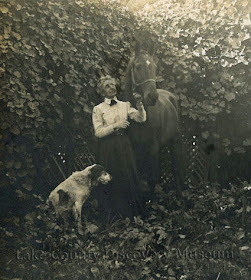Harness racing at the Waukegan Fair's race track, Waukegan, Illinois, circa 1878.
Dunn Museum, Glass Negatives Collection, 93.32.142.
Horse racing, specifically harness racing, was a wildly popular past-time in Lake County from the 1850s to the 1910s. In Lake County, there were three harness racing tracks: McKay's in Waukegan, the Libertyville Trotting Association, and the Lake County Fair in Libertyville.
James McKay's racetrack was built about 1852 and located where the Karcher Hotel building still stands on Washington Street in Waukegan. It was used for "trotting matches" and as the site of the first Lake County Fair.
Waukegan Fair's (McKay's) racetrack, circa 1878. Note the county courthouse in the distance at center.
BBDM Glass Negative Collection
Chicago Tribune column on 4th of July activities at Waukegan
in 1860, including "trotting matches" at McKay's track.
Black Weasel, owned by Mr. Arnold, won $50 in the mile heat.
It was a given that county fairs needed a racetrack to draw crowds, and harness racing was a featured attraction. When the Lake County Fair moved to Libetyville the new fairgrounds included a racetrack.
From 1858 - 1881, the Lake County Fairgrounds were located at Milwaukee Avenue and Winchester Road (now Winchester House), and then at Appley Avenue (now Lake Minear) from 1882 - 1925.
Lake County Fairgrounds and racetrack on the site of today's Lake Minear,
Libertyville, circa 1907. Dunn Museum M-86.1.655
Another view of the Lake County Fairgrounds racetrack with harness racers coming around the turn,
about 1910. Dunn Museum M-86.1.646
In 1904, a new racetrack opened called the Libertyville Trotting Association Track. It was located on 100 acres west of Garfield Avenue and south of Route 176. Locals often refer to this track as the "one-mile track," although all harness racetracks are required to be one-mile.
Libertyville Trotting Association Track in use from 1904 - 1918. This colorized postcard is from about 1914 and shows the track during its motorized race days. Dunn Museum M-86.1.658
For the first several years, the Trotting Association Track featured harness racing, and then was used as a training track for harness races. By the 1910s, the popularity of automobile and motorcycle races monopolized the Libertyville track, and harness racing's popularity began to wane. In 1918, Samuel Insull purchased the property and closed the track.
One of the regionally known trotters was King Heyday (1891 - 1919), owned by Edward and Charlotte DeWolf of Waukegan. (pictured below)
Edward Dewolf with his prize trotter, King Heyday, circa 1910.
King Heyday was foaled on August 18, 1891. Dunn Museum, DeWolf Collection
Edward DeWolf (1848-1927) was an influential businessman in Waukegan, a promoter of the Electric Railroad line, and a mayor of Waukegan (1895-97). He was a lover of history, historical preservation, nature, and a keen horseman. He and his wife, Charlotte, owned several trotting horses, but King Heyday was their favorite.
Edward P. DeWolf (1848 - 1927)
King Heyday, was bred at the J.W. Swanbrough Stock Farm on Sheridan Road in Waukegan Township. King Heyday's sire was Prairie King (pictured below) and dam Mabel H.
Prairie King (King Heyday's sire), photographed in 1890
at the Swanbrough Stock Farm. Dunn Museum, DeWolf Collection
The stock farm was owned and operated by John W. Swanbrough (1843 - 1924), who fought with the 96th Illinois in the Civil War. Swanbrough was a member of the Illinois Association of Horse Breeders, and served as Lake County Sheriff (1876-1886).
With the popularity of harness racing came the need to breed trotters or "standardbreds." The term appeared in 1879 based on the racing standard of a one-mile track and standard time of 2.5 minutes maximum. A horse bred to these standards was "standardbred."
Swanbrough Stock Farm catalogue, 1891
Steenbock Memorial Library, University of Wisconsin-Madison
King Heyday with Charles Heydecker, circa 1905.
Heydecker bred and owned King Heyday's dam, Mabel H.
Dunn Museum, DeWolf Collection
Edward DeWolf called King Heyday: "the handsomest horse that I had ever seen" and "a horse with remarkable speed."
King Heyday took his record of 2.17 at the Milwaukee Mile. DeWolf boasted: "his mile really being in 2.13." The Milwaukee Mile was a private horse racing track established by 1876. In 1891, the property became the permanent home of the Wisconsin State Fair.
Charlotte DeWolf loved "driving" King Heyday, whom she nicknamed "Punch." She took him out every day, except Sundays, for a drive in a carriage or sleigh. (pictured below)
Charlotte DeWolf being pulled in a sleigh by her beloved King Heyday, nicknamed "Punch."
The DeWolf's setter, Laddie, is barely visible at left. Dunn Museum, DeWolf Collection
According to DeWolf, King Heyday was "Charlotte's pet, and he seemed to understand and return the love she had for him."
Charlotte DeWolf with King Heyday and Laddie, circa 1915. Dunn Museum, DeWolf Collection
King Heyday died on December 10, 1919, and Charlotte DeWolf passed away eight days later.
~ ~ ~
Special thanks to museum collections volunteer, Cynthia Kolanko, for her dedication to processing the Edward DeWolf Collection and bringing King Heyday's story to light.
- Diana Dretske, Curator ddretske@lcfpd.org














Great article. There was also the Ideal horsetrack and Ideal Inn right on the state line near Russel. I think they did some harness racing there, but I don't think Ideal was a large a track as the ones you talked about. Also I don't think Ideal got started until the 1890's or so.
ReplyDeleteThank you! I have a lot of research on the Ideal track located just over the border in Wisconsin. Definitely worth a mention.
ReplyDelete